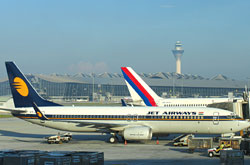|
|
We have had the Delhi-Lahore, Madras-Colombo, Dhaka-Calcutta, Karachi-Bombay flights going for a long time. But why isn't Kathmandu linked to Lahore? Why is there no air corridor between bustling Bangalore and upwardly mobile Dhaka or between Madras and Karachi and Colombo?
In some ways, we are going backward, because for a brief period in the late 1980s, Royal Nepal Airlines did operate the KTM-CMB route and a more exotic flight from start to finish was hard to find. Taking off to the east from Kathmandu, flying astride Mount Everest before heading south and cutting across the Deccan heartland of the subcontinent, the plane would descend over the coconut plantations on the Sri Lankan coast to land at Katunayake. It was a flight that should have survived but air routes are not managed by romantics and Royal Nepal cancelled when the expected tourist traffic did not emerge to fly between Serendib and Shangri La.
Indeed, the hard realities of economics as well as historical distancing are what determine links between Southasian cities beyond the difficulties of visa application and approval. Simply put, the Partition was such a radical, invasive surgery that the social, cultural, familial and economic sinews were torn asunder.
While rail and bus links should certainly be favoured over air connections for the movement of the public at large, one could at least start with more flights between more cities. That would be less threatening to all the home ministries concerned.
The economic links between the various regions of erstwhile, undivided India, between cotton producers in Sindh and ginning factories in Gujarat, between mango orchards around Multan and the mandis of Old Delhi-all have been turncated. It will take years to revive these connections, which means that there will not be an immediate demand for flights, say between Delhi and Multan, based on the needs of trade and commerce.
The families that were torn apart during Partition might have provided some passenger volume to fuel new airline networks but that link, too, now is weathered and withered. The generation that went across during Partition in their late teens is now in its late seventies. Familial continuity is now the stuff of faded photo albums and memories. What remains is cultural affinities between peoples who speak with the same lilt, who share a history and heritage. This is a link that is required to energise inter-regional travel but is not enough to be an effective catalyst.
As the countries of Southasia continue with the process of opening up their trade regimes, granting each other MFN status, simplifying visa procedures the demand for increased flights between existing destinations is bound to pick up. We need coordinated moves by the civil aviation authorities of the seven countries of SAARC to encourage each other's carriers in flying between Southasian airports.
SAARC immigration counters could be set up at arrival halls, visas-on-arrival could be considered, drastically reduced landing and handling charges for SAARC airlines must be granted, as also support for stationing of immigration and customs personnel in cities which are keen to go regional. These and other inducements to the regional flag carriers and private airlines would be the least that could be done to ensure that cities of great heritage, ebullient cultures and economic strength communicate with sister cities.
We are by now half-hour out of Kathmandu and the jet banks sharply to the right on its programmed flight path, turning over Lucknow and setting course for IGI. Looking down from 36,000 feet (so says Capt Tomar), the city of Lucknow is spread out beneath us like a carpet. The Bada and Chota Imambaras are too small to tell from this height but there one can see the straight line of Hazratganj, pointed like a staff at the serpentine Gomti which flows past the stadium and there is the sprawl of Mahanagar on the other side.
Come to think of it, this great capital of Avadh, this jewel of Southasian heritage, is not linked to any other country by air. This is the city where the airline Sahara (recently acquited by Jet) is based and yet Lucknow is not linked with Lahore, with whose high culture it shares so much. Neither is Lucknow linked to Dhaka, nor Kathmandu.




